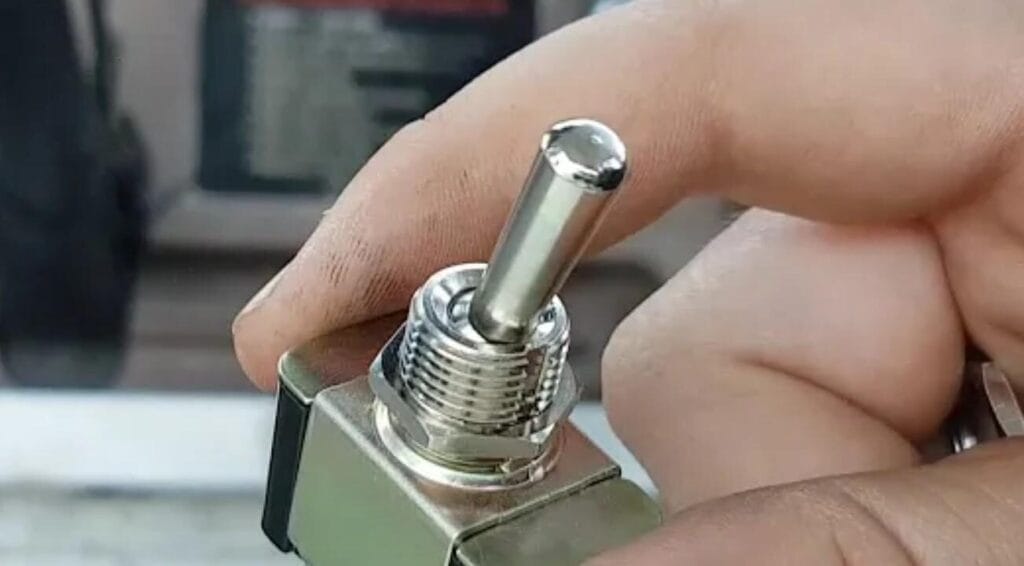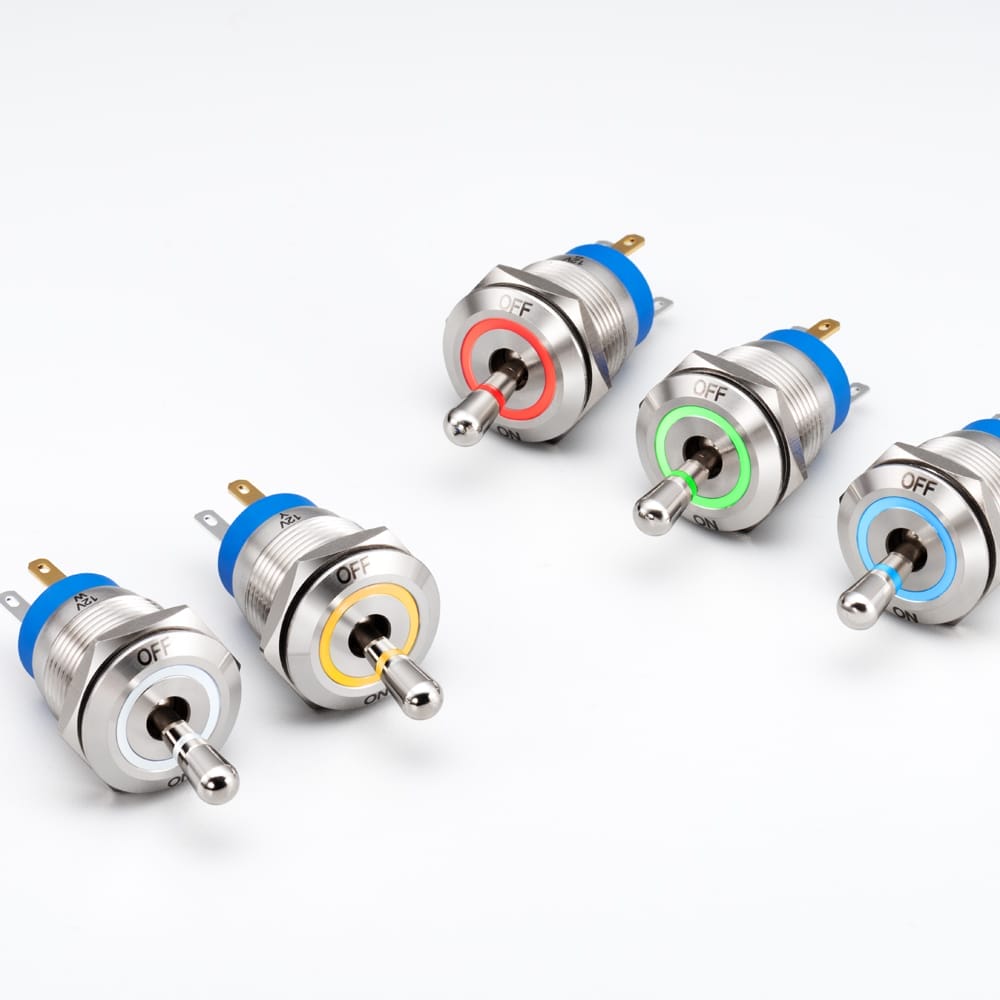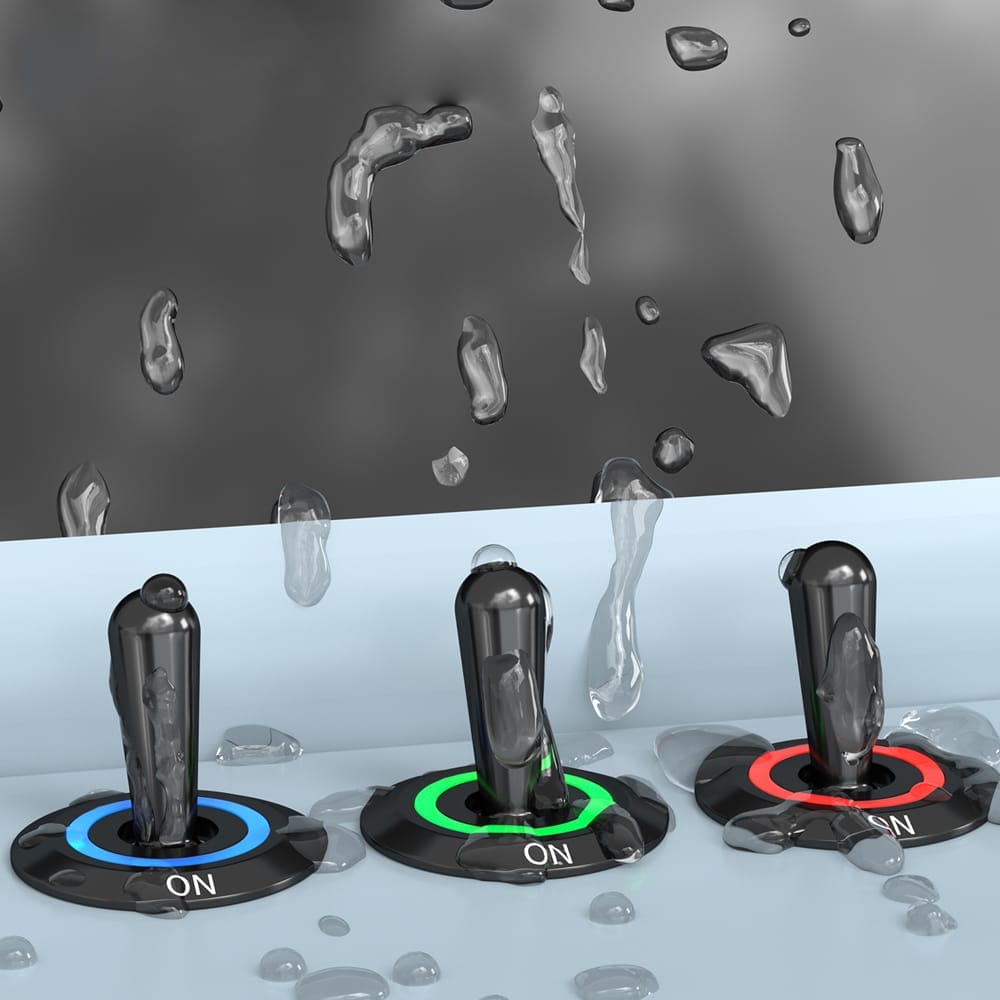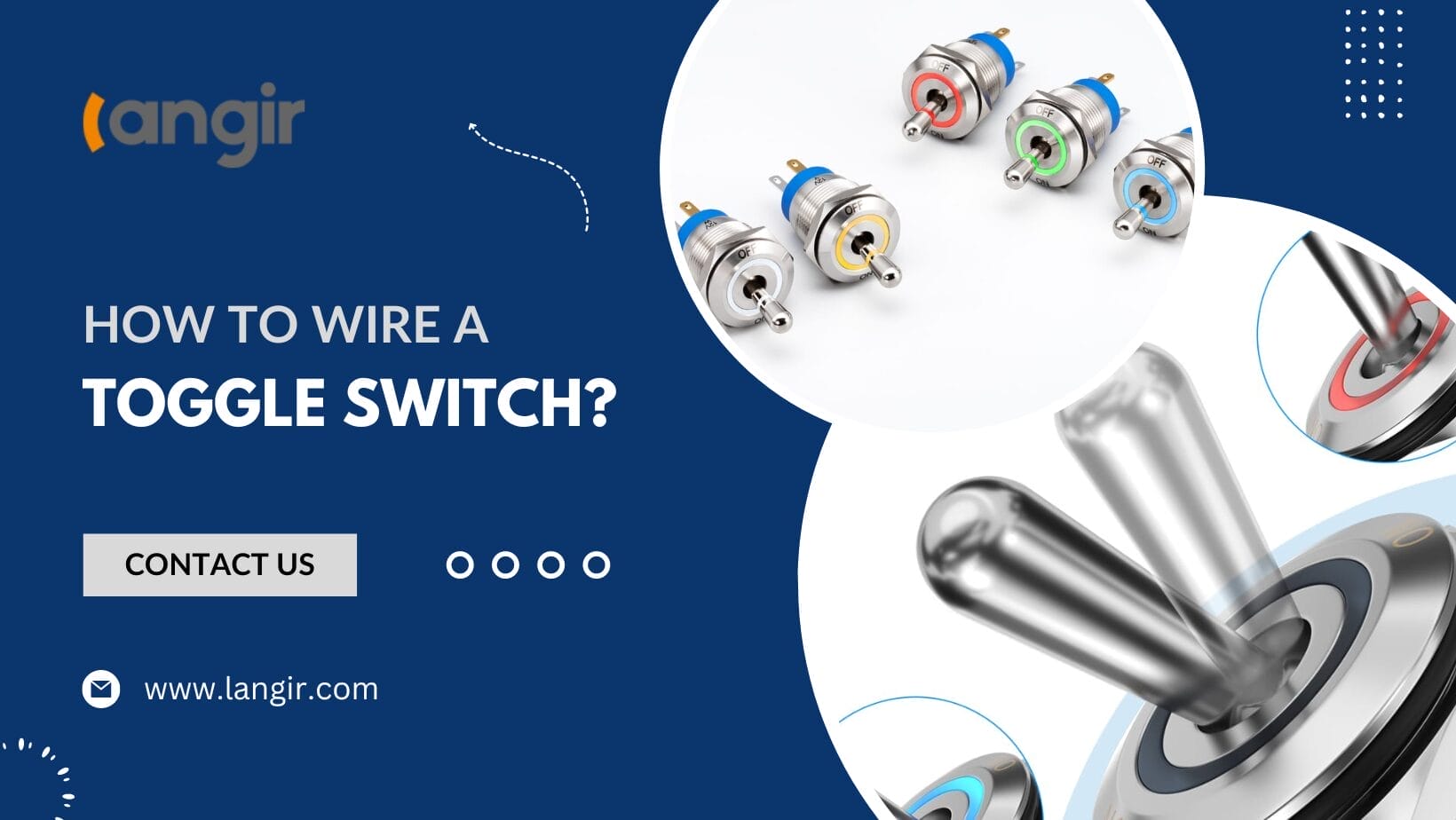
Toggle switches are simple on-and-off switches that provide tactile feedback on operation. LED toggle switches, SPST toggle switches, DPDT toggle switches, and more are some types of toggle switches. Despite their widespread use, there’s a query: how to wire a toggle switch. The process isn’t difficult if you know the basics and how to work with electrical components.
Continue reading to demystify the process of how to wire a toggle switch, getting a detailed exploration of the essential steps.
Components and Working of a Toggle Switch
Before discussing how to wire a toggle switch, let’s have an overview of its construction and working.
Construction
The components of a toggle switch that you must learn about before diving into the details of how to wire a toggle switch are:
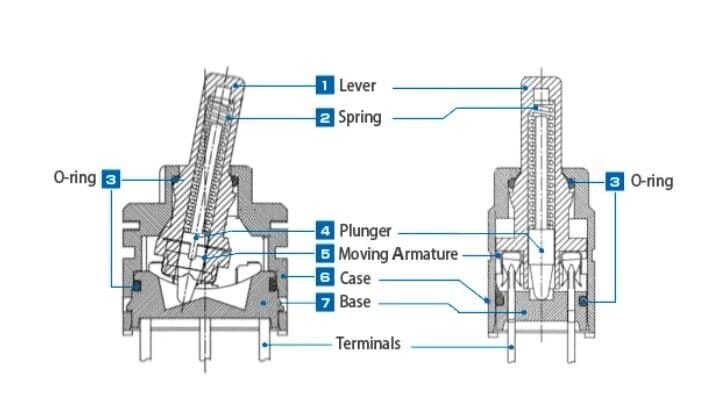
It’s the external handle that users physically manipulate to actuate the switch. It provides a mechanical advantage for the toggle switch, allowing for easy toggling between on and off positions.
A crucial component that lets the toggle switch return to its default position when the lever isn’t actuated. The spring mechanism ensures a reliable and consistent switching action.
The O-ring is a rubber part that connects the case, base, and other moving parts of the toggle switch. It protects the lever from dust, moisture, or other foreign elements. Hence, it ensures the longevity and durability of the toggle switch.
The plunger is the component of a toggle switch that moves in response to the lever’s manipulation. The working is simple: the plunger’s movement triggers the internal mechanism. This allows electrical contacts to open or close based on the switch’s position.
The lever has a U-shaped contact, which is known as a moving armature. The tip of this U-shaped contact moves with the lever, and the terminals are placed between the tips to turn the switch on.
The outer shell or housing encloses and protects the internal components. Its purpose is to offer structural integrity to the toggle switch. This ensures the switch functions to the fullest while safeguarding it from external factors.
It’s the foundation for mounting and securing the internal elements. This provides stability to the switch and often includes terminals for connecting wires.
Toggle Switch Working
Now that you know the components of a toggle switch, let’s go through its working before moving on to how to wire a toggle switch:
How to Wire a Toggle Switch?
It’s time! Let’s look at the steps that help in how to wire a simple toggle switch:
Step 1: Installing a Toggle Switch in Your Device’s Panel
First things first, mount the switch to your device’s control panel. The process for this is given as:
-
- 1. Disconnect all power from the device before starting. The method varies based on the device, like disconnecting the negative battery terminal for cars or unplugging the power supply for other devices.
-
- 2. Remove the panel or housing to access the internal wiring. This involves taking off the exterior paneling or housing. Try to remove only the necessary section where you intend to install the switch using screwdrivers, pry bars, or other tools.
- 3. Measure the diameter of the switch bushing for the hole that will protrude through the panel. This will help you find out the size and shape of the hole you should make. In the case of toggle switches, it’s usually a circular-shaped hole.
- 4. Drill or cut a hole in the panel to fit the switch; use an appropriate tool such as an HSS twist drill bit for wood, plastic, jigsaw, sandpaper, or mild steel.
- 5. Install the toggle switch from the underside of the panel; place the switch into the hole, securing it in place with its mount. This involves passing the switch through the mount and tightening it with a nut, such as threading a jam nut onto its bushing for a basic toggle switch setup.
Step 2: Wiring Your Toggle Switch to Your Device
Next, let’s discuss how to wire your toggle switch to your device. The steps for that are:
-
- 1. Consult the instructions provided with your switch or device. The electrical configurations of devices can vary significantly, and these steps are general guidelines for a simple on-off toggle switch (SPST).
-
- 2. Consult a skilled electrician if in doubt to save time and avoid inadvertent damage.
- 3. Cut the supply wire in your device using wire cutters, allowing for routing both ends to the toggle switch. Strip approximately 1⁄ 2 inch (1.3 cm) of insulation from each end using a wire stripper.
-
- 4. Add a pigtail if needed for extension. Find out the gauge of the existing wire, cut a piece of the same gauge, and strip half an inch of insulation from each end. Connect one end to the supply wire using a wire nut.
-
- 5. Attach the supply wire to the toggle switch based on its type:
-
- For toggle switches with wire leads, twist the end of each lead to the supply wires and secure it with wire nuts.
- In the case of toggle switches with screw terminals, loop the ends of supply wires over the terminals and tighten the screws.
- For toggle switches with solder connections, bend wire ends around switch terminals, heat with a soldering iron, and allow the solder to flow and cover the joint.
-
- 6. Test your switch by carefully reconnecting the device’s power supply. If it functions as intended, you can replace the panel or device housing, completing the successful installation of a toggle switch.
- 5. Attach the supply wire to the toggle switch based on its type:
That’s it, and you are all done with how to wire a toggle switch!
Safety Precautions
The safety precautions you should consider for the how to wire a toggle switch process are given:
It’s a never-miss thing! You must turn the power source off before proceeding with how to wire a toggle switch. This helps prevent any possible electrical shock and short circuit issues.
Even if you’ve turned off the power source, you should use a voltage tester to make sure that the power is off before starting the wiring work. This offers an extra layer of safety by double-checking that no live electrical current is present.
The selection of tools for how to wire a toggle switch should be right. You should pick insulated screwdrivers and wire strippers. They lessen the risk of accidental contact with live wires, thus enhancing overall safety during installation.
This safety tip is a must! You should properly understand and follow the manufacturer’s guidelines for how to wire a toggle switch. Why? Different toggle switch types have different methods of installation. Following the guidelines ensure a proper installation.
In case you lack the technical efficiency that a how to wire a toggle switch process requires, you must get help from an electrician. It’s because electric work is hazardous, and professional assistance can save you from any unfortunate incident.
Don’t forget to wear your protective gear, including safety glasses and insulated gloves. This is an additional safety layer against the risks linked with electrical components.
Must inspect your device’s wiring for signs of wear, damage, or loose connections. If there’s any issue, address it promptly. It helps prevent electrical problems and maintain a safe working environment.
Best Toggle Switches to Go For!
Now that you know how to wire a toggle switch, let’s look at the top toggle switch options to try:
Operating in temperatures from -20 °C to 55°C, it offers versatility. The IP code IP67 ensures it excels in challenging environments. In addition, the actuation force of 4N provides a tactile response. Its adaptable panel thickness range of 1-10mm suits various setups. The mounting nut torque requirement of 5-14Nm ensures secure installation. Therefore, making this toggle switch is a durable and efficient choice for your electrical control needs.
What to Consider When Purchasing a Toggle Switch?
All done with how to wire a toggle switch and the best option to try? Let’s discuss the key parameters of selecting the best toggle switch for your particular needs.
Firstly, thoroughly evaluate the toggle switch’s compatibility with your specific application. Consider factors like voltage, current, and environmental conditions to ensure seamless integration.
Pay close attention to the type of toggle switch. Options include single pole, double pole, single throw, double throw, LED, etc. Selecting the right type is crucial to meeting your intended use and functionality requirements.
Never overlook the electrical rating of the switch. Confirm that it aligns with the demands of your circuit or device in terms of current and voltage. For instance, if your device requires a 12 A current, don’t use a 10 A-rated switch. This is important for reliable and safe operation.
Here’s the thing – don’t forget to consider the mechanical life of the toggle switch. See how many cycles a toggle switch can endure, ensuring it matches your anticipated usage patterns. Why? A switch with an appropriate mechanical life ensures longevity and durability.
Balance the cost with the quality of the toggle switch. Avoid compromising quality for a lower price if the switch is critical for the performance and safety of your system.
FAQs
What is the Voltage of a Toggle Switch?
The voltage of a toggle switch varies and depends on the specific model and application. Toggle switches are available in a range of voltage ratings. Usually, you’ll see these switches having a 12 V or 15 A rating. It’s always a good idea to check if the switch matches the voltage rating of your device or application.
What Does 1 2 3 Mean on a Toggle Switch?
The numbers on a toggle switch signify the following: Terminal 1 connects to one load or accessory, Terminal 3 connects to another load or accessory, and Terminal 2 is linked to the power source. The switch toggles between the two connections and maintains a continuous current flow.
What is a 4-Way Toggle Switch?
A four-way switch, akin to a three-way switch, features four terminals. There’s one ground terminal and three other terminals enabling control of a single fixture from three locations. It proves beneficial in larger rooms with multiple entrances, offering enhanced control and convenience.
Conclusion
How to wire a toggle switch is a simple process. Just follow the steps mentioned earlier, stay safe, and you’ll easily install and wire the switch. The safety precautions include wearing protective gear, turning off the power source, inspecting wires, and more. In case you want high-quality toggle switches, Langir is here to help.
Our toggle switches are cost-effective, feature excellent life cycles, and work smoothly in harsh weather conditions. That’s why we have earned the reputation of being among the best toggle switch sellers. Get in touch with us today and have the best toggle switches that are durable and easy to wire!
Send your inquiry now
All Langier News:
Read Moreelectronica 2024 Hall-Stand No.: A2 160 November 12-15, 2024 Tr...

 English
English 简体中文
简体中文